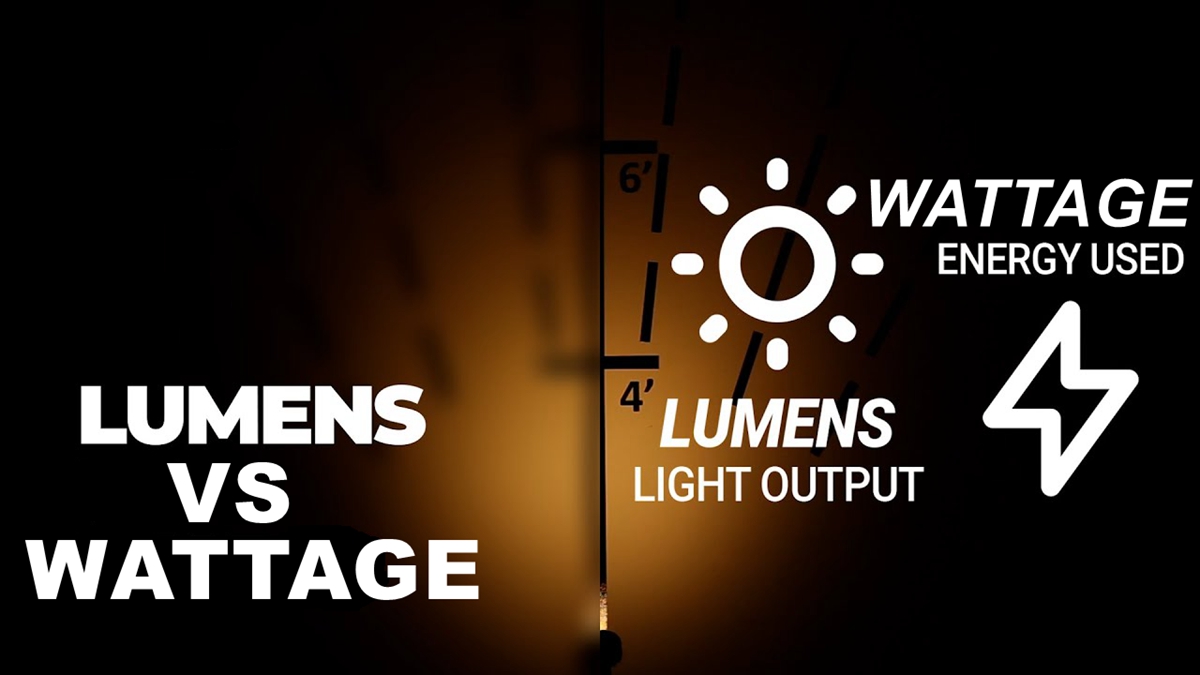
A light bulb's wattage was once used as a measure of its brightness. Lighting with 60 watts, for instance, would have always been brighter than those with 40 watts. This made finding replacement bulbs of the same brightness easier.
This worked for a long time. When energy-saving lighting – in particular, LED lighting – emerged, everything changed because a higher wattage was no longer synonymous with a brighter light due to the energy efficiency of the new light bulbs. For example, a 10W LED light bulb is brighter than a 40W incandescent light bulb.
Table of Contents [hide]
Lumens are the brightness a light gives off. More lumens mean a brighter light, fewer lumens mean a dimmer light.
When you want to buy a light based on its brightness, you should always think about the number of lumens, instead of the wattage. For example, a 20-watt ZGSM Rifle series LED street light replacement is brighter than a 100-watt halogen light, because of the number of lumens. A 20-watt LED produces around 3000-3400 lumens.
If you have a standard 150-watt bulb in the street that that is giving out 4500-5100 lumens, you replace it with a 30 watt LED streetlight. The power used by the new 30-watt street LED light will be significantly reduced, but the light will still produce the same amount of light.
LED lighting technology can reduce energy consumption by up to 80% compared to incandescent or halogen or HPS lighting. This is because LED lights have a longer lifespan and use less power. LED lighting is not only more energy-efficient, but it's also cheaper to run.
ZGSM Rifle Series LED Street Light With 170lm/W
Wattage isn't a measure of brightness but of how much electricity (or energy) it takes to achieve a level of brightness or luminosity. There are different lumen to watt ratios for LEDs, fluorescents, halogens, and incandescents.
A light's wattage no longer tells you how bright it is, but it is still an important measure in many other ways.
It's important for safety reasons not to exceed a dimmer switch's maximum wattage (specified by the manufacturer). For example, dimmers can only handle lights of certain wattage.
You may not be surprised to learn that LED lighting has made things more complicated. We can determine the energy efficiency of a light bulb by using watts and lumens together.
Consumers often wonder how lumens compare to wattage ratings when it comes to LED lighting. We are so used to seeing watts listed on the incandescent light bulb packaging. Lumens and watts measure different things, which is why this is such a confusing concept.
Wattage is a measure of how much power the LED light consumes, while lumens measure how much light it emits. Lumens indicate how bright a bulb is, not wattage.
The efficiency of LEDs, CFL bulbs, fluorescent, and halogens all differ from bulb type to bulb type, but all are more efficient than incandescents.
Here's an idea of the different lighting outputs:
LED Light Fixture: A 50w LED lights >7500 lumens.
COMPACT FLUORESCENT: A 15w CFL produces >850 lumens.
HALOGEN: A 45w Halogen bulb produces >750 lumens.
INCANDESCENT: A 60w incandescent produces >700 lumens.
LEDs are the obvious choice for efficiency.
Manufacturers of lights include a lumens (LMS) number on their packaging to allow consumers to compare light output across different types of lights. Lamps are measured by lumens, regardless of the type of light or the amount of power they use.
In contrast to how much energy a lamp consumes (watts), lumens are a better indicator of lighting performance. In general, the higher the lumen value, the more light the light emits. However, a high lumen value doesn't necessarily mean a high power requirement.
Look at the packaging of LED lighting to compare them with other types of lamps. On the lamp's output page, you will see the lumens and wattage. If the light fixtures produce similar amounts of light, compare their lumen numbers, then compare their wattage requirements to determine how much energy each bulb consumes.
You can easily identify the brightness of a light and the amount of energy it consumes using these two numbers. Choose the lamp that has the lowest wattage that has the light output you need. This will be the most energy-efficient lamp for your demands.
With an understanding of watts and lumens, we can determine lumens per watt or "efficiency". Sometimes efficiency is also called "luminous efficacy".
Energy (wattage) converted into light (lumens) by a light source is measured here. LED technology can produce about 150~170 lumens per watt (lm/W), as opposed to the 15 lumens/watt efficiency of old tungsten or incandescent bulbs.
LED lights produce light about ten times more efficiently than incandescent bulbs. When replacing an incandescent bulb, the 10:1 ratio is a rough guide for choosing the right LED bulb.
A good estimation would be to divide 100 watts by 10 to get 10W if you are replacing a 100-watt incandescent bulb with an LED lamp. Efficacy, however, varies widely from manufacturer to manufacturer, which is why you should compare the luminance on the label and try to match the efficacy. An LED lamp's label may state that it has an equivalent brightness, but it may not.
The Formula for Converting Watts to Lumens
The luminous flux ΦV in lumens (lm) equals the power P in watts (W) multiplied by the luminous efficacy η in lumens per watt (lm/W):
ΦV(lm) = P(W) × η(lm/W)
Therefore,
Lumens(lm) = Watts (W) × Lumens per Watt (lm/W)
Lumens (lm) are today's unit of measurement for energy-efficient LED lights, and the number of lumens indicates how bright the bulb is. Compared to watts, which measure how much energy a bulb uses, lumens better measure light quality. When replacing the old lamps, the easiest way is to check the lumens of old lamps and purchase the LED lights with the same lumen output.
If you don't know the lumens of old lamps, you could also check the power on the lamps and purchase LED lights with 10%-20% power of old lamps.
If you don't know both the lumens and wattage of old lamps, you can inform the supplier of the lighting requirements of places you want to install the lamps to, then they will recommend you the suitable lamps. ZGSM, as a professional manufacturer of LED lights for more than 17 years, provides free service of DIALux simulation according to your requirements and offer you the best lighting solutions. If you have any questions or demands about LED lighting, pls feel free to contact us.

LED Street Lighting Project In Norway
There are now a lot of things to consider when it comes to lighting levels. Light Wattage versus Lumens is one of the biggest arguments. It used to be that you looked at the wattage of light to determine how bright it would be, and with incandescent lamps, the higher the wattage, the brighter it would be. To determine the brightness of the lamp, we need to look at the Lumens of the lamp, especially when it comes to LEDs. Ultimately, a more energy-efficient lighting system will take into account lighting levels and lumens over wattage. Lamps with higher lumens and lower wattage, especially LEDs, will provide the best lighting while consuming the least energy.
LED auto lighting is superior because it is much more energy-efficient, shines much brighter at lower energy usage, and is much more durable than conventional lighting. Contact Brooking to ensure you obtain the right LED lighting equipment for your emergency vehicle fleet.
LED means Light-emitting diodes. These are electronic components that use the passage of electrons within the diode's substance to directly transform electrical energy into light. LEDs are significant because they are starting to replace the majority of traditional light sources thanks to their efficiency and low energy consumption.
Color temperature is a crucial component of color appearance that determines how "warm" (yellowish) or "cool" (bluish) white light looks on paper. A warm light is approximately 2,700 degrees Kelvin (K), neutral white is approximately 4,000 K, and cold white is approximately 5,000 K or greater. Correlated Color Temperature, or CCT, is specified in degrees Kelvin. When compared to the enormous efficiency benefits made by switching from conventional incandescent to LED lights, the energy efficiency variations between colder and warmer color temperatures are very insignificant.
Each LED module is driven by a constant current driver. In this type of system, the main supply generates an isolated fixed voltage of typically 24 or 48V that is low enough to comply with UL safety limits.
For AC drivers, there are narrow voltage (200-240VAC) drivers and wide voltage(90-305VAC) drivers. You could choose the suitable drivers according to the voltage of mains of the country you will install these LED street lights to.
Sometimes for industrial lighting, we also need to choose high voltage drivers with 347VAC, 480VAC or 528VAC.
Share the Post
Add: 1-1 Dabai Road, Lin’an District, Hangzhou, 311300 Zhejiang, China.
Copyright © Hangzhou ZGSM Technology Co., Ltd. All Rights Reserved
